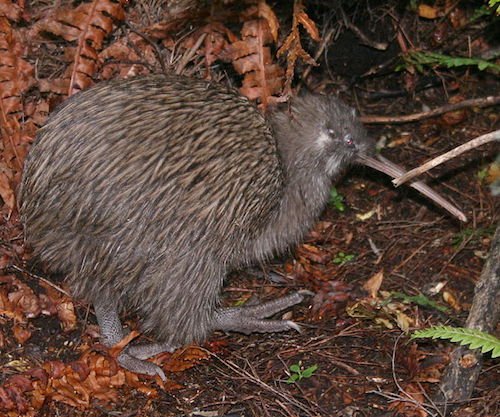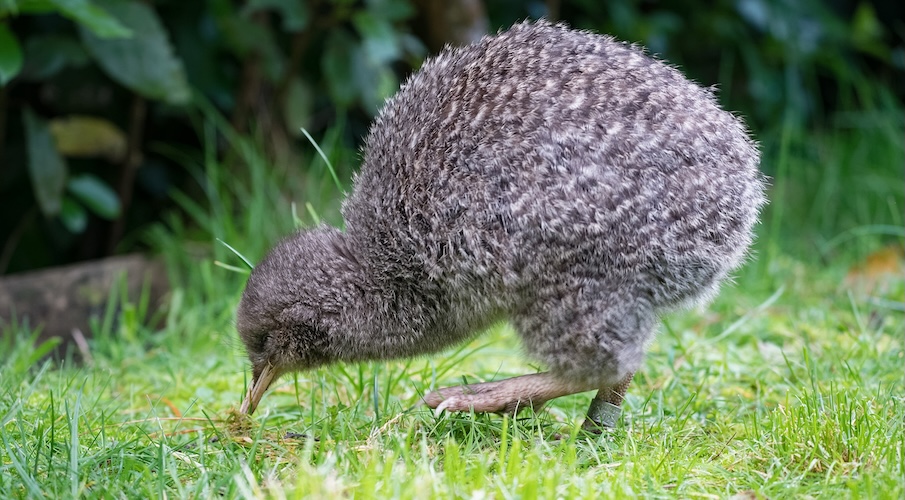Apterygidae – Kiwis

Kiwis are flightless birds native to New Zealand, in the genus Apteryx and family Apterygidae. Traditionally the order Struthioniformes contained all the world’s ratites including kiwis, rheas, emus and cassowaries. However, recent genetic analysis has found that the group is not monophletyic, as it is paraphyletic in respect to the tinamous. The ratites are now split into a number of families, with Kiwis in one of their own.
At around the size of a domestic chicken, kiwi are by far the smallest living ratites and lay the largest egg in relation to their body size of any species of bird in the world.
DNA sequence comparisons have yielded the surprising conclusion that kiwi are much more closely related to the extinct Malagasy elephant birds than to the moa with which they once shared New Zealand. There are five recognised species, two of which are currently vulnerable, one of which is endangered, and one of which is critically endangered. All species have been negatively affected by historic deforestation, but currently the remaining large areas of their forest habitat are well protected in reserves and national parks. At present, the greatest threat to their survival is predation by invasive mammalian predators such as mustelids.
They prefer subtropical and temperate podocarp and beech forests, but they are being forced to adapt to different habitat, such as sub-alpine scrub, tussock grassland, and the mountains. Kiwi have a highly developed sense of smell, unusual in a bird, and are the only birds with nostrils at the end of their long beaks. Kiwi eat small invertebrates, seeds, grubs, and many varieties of worms. They also may eat fruit, small crayfish, eels and amphibians. Because their nostrils are located at the end of their long beaks, kiwi can locate insects and worms underground using their keen sense of smell, without actually seeing or feeling them.

Little Spotted Kiwi Apteryx owenii – ©Judi Lapsley Miller CC BY 4.0 via Wikimedia Commons
Their adaptation to a terrestrial life is extensive: like all the other ratites they have no keel on the sternum to anchor wing muscles. The vestigial wings are so small that they are invisible under the bristly, hair-like, two-branched feathers. While most adult birds have bones with hollow insides to minimise weight and make flight practicable, kiwi have marrow, like mammals and the young of other birds. With no constraints on weight due to flight requirements, brown kiwi females carry and lay a single egg which may weigh as much as 450g. Like most other ratites, they have no preen gland. Their bill is long, pliable and sensitive to touch. Their feathers lack barbules and aftershafts, and they have large vibrissae around the gape. They have 13 flight feathers, no tail and a small pygostyle. Their gizzard is weak and their caecum is long and narrow.
Kiwis are shy and usually nocturnal. Their mostly nocturnal habits may be a result of habitat intrusion by predators, including humans. In areas of New Zealand where introduced predators have been removed, such as island sanctuaries, kiwi are often seen in daylight.
Once bonded, a male and female kiwi tend to live their entire lives as a monogamous couple. During the mating season (June to March), the pair call to each other at night, and meet in the nesting burrow every three days. These relationships may last for up to 20 years.
The kiwi is a national symbol of New Zealand, and the association is so strong that the term Kiwi is used internationally as the colloquial demonym for all New Zealanders.
-
Number of bird species: 5
(As at July 2025)
There are just five species of kiwi in the family Apterygidae, all living exclusively in New Zealand; they are:
Little Spotted Kiwi Apteryx owenii
Great Spotted Kiwi Apteryx maxima
Southern Brown Kiwi Apteryx australis
Okarito Kiwi Apteryx rowi
North Island Brown Kiwi Apteryx mantelli
-
Kiwi Conservation Club
WebsiteThe Kiwi Conservation Club is a Forest and Bird project for children. -
Kiwis for kiwi
WebsiteKiwis for kiwi is carrying on the years of dedicated work by BNZ Save the Kiwi Trust, to help protect kiwi and the places they live. Because we can -
NZ Kiwi Foundation
Facebook PageWe are a voluntary organisation working to ensure kiwi survival on mainland NZ -
The Kiwi Trust
InformationThe kiwi is New Zealand's national bird, and its future survival is of great concern not only to New Zealanders but internationally
-
Kiwi - The People's Bird
| By Neville Peat | Otago UP | 2006 | Paperback | 176 pages, Colour & b/w photos, colour illustrations | Out of Print | ISBN: 9781877372360 Buy this book from NHBS.com
-
Apterygidae - Kiwis
Family AccountApterygidae - Kiwis Classification Kingdom: Animalia Phylum: Chordata Class: Aves Order: Struthioniformes Family: Apterygidae kiwiThere are five species of stout, chicken-sized birds in this family. All species are found in the forests of New Zealand. -
Kiwi
Family AccountApproximately the size of a domestic chicken, kiwi are the smallest ratites (which also include ostriches, emus, rheas, cassowaries and the extinct elephant birds and moa).
NB All species are monotypic several having formerly been regarded as races of Southern Brown Kiwi.
-
Great Spotted Kiwi Apteryx maxima
Species AccountBirdLife species profile... -
Great Spotted Kiwi Apteryx maxima
Species AccountLarge, light grayish brown kiwi with white horizontal banding or mottling along the length of the body. Restricted to the native forests, scrubland... -
Great Spotted Kiwi Apteryx maxima
Species AccountThe great spotted kiwi, as a member of the ratites, is flightless. It is the largest of the kiwi. The rugged topography and harsh climate of the high altitude alpine part of its habitat render it inhospitable to a number of introduced mammalian predators, which include dogs, ferrets, cats, and stoats. -
Great Spotted Kiwi Apteryx maxima
Species AccountNZ Birds Online species account and image... -
Great Spotted Kiwi Apteryx maxima
Species AccountSound archive and distribution map... -
Little Spotted Kiwi Apteryx owenii
Species AccountBirdLife species profile... -
Little Spotted Kiwi Apteryx owenii
Species AccountNew Zealand's smallest kiwi species. Light grayish brown with white horizontal banding or “spotting” along the length of the body. -
Little Spotted Kiwi Apteryx owenii
Species AccountThe little spotted kiwi (Apteryx owenii), also known as little grey kiwi... -
Little Spotted Kiwi Apteryx owenii
Species AccountSound archive and distribution map. -
Northern Brown Kiwi Apteryx mantelli
Species AccountIUCN species profile... -
Northern Brown Kiwi Apteryx mantelli
Species AccountNZ Birds Online species account with image... -
Northern Brown Kiwi Apteryx mantelli
Species AccountThe eggs laid by the North Island brown kiwi are among the largest eggs relative to its body size... -
Northern Brown Kiwi Apteryx mantelli
Species AccountA large, dark grayish brown kiwi with reddish brown streaking. The only kiwi found in the wild on the mainland of New Zealand’s North Island. Found in both native and exotic forest, scrub, and neighboring farmland. More often heard than seen. -
Northern Brown Kiwi Apteryx mantelli
Species AccountBirdLife Species profile... -
Okarito Kiwi Apteryx rowi
Species AccountBirdLife species profile... -
Okarito Kiwi Apteryx rowi
Species AccountNZ Birds Online species account... -
Okarito Kiwi Apteryx rowi
Species AccountSound archive and distribution map. -
Southern Brown Kiwi Apteryx australis
Species AccountDistribution etc... -
Southern Brown Kiwi Apteryx australis
Species AccountThe North Island brown kiwi (Apteryx mantelli; Apteryx australis or Apteryx bulleri as before 2000, still used in some sources), is a species of kiwi that is widespread in the northern two-thirds of the North Island of New Zealand and, with about 35,000 remaining, is the most common kiwi. This bird holds the world record for laying the largest eggs relative to its body size. -
Southern Brown Kiwi Apteryx australis
Species AccountBirdLife species profile... -
Southern Brown Kiwi Apteryx australis
Species AccountNW Birds Online species account and image... -
Southern Brown Kiwi Apteryx australis
Species AccountSound archive and distribution map.
-
Incubation Temperatures of Great Spotted Kiwi Apteryx Haastii
ArticleJ.A. McLENNAN and A.J. McCANN - New Zealand Journal of Ecology, Vol. 15, No. 2 (1991), pp. 163-166 -
Metabolism and Temperature Regulation of Kiwis (Apterygidae)
ArticleBrian K. McNab - The Auk, Vol. 113, No. 3 (Jul., 1996), pp. 687-692
-
Brown Kiwi Apteryx australis
Gallery -
Little Spotted Kiwi Apteryx owenii
VideoTaken on a night tour at Zealandia wildlife sanctuary in Wellington, New Zealand on January 13, 2014. -
Northern Brown Kiwi Apteryx mantelli
VideoThis video is from the Otorohanga Kiwi House & Native Bird Park and shows a Kiwi chick hatched 11 October 2009 being removed from its underground burrow to ensure its survival as this species of native New Zealand bird is a threatened species.
